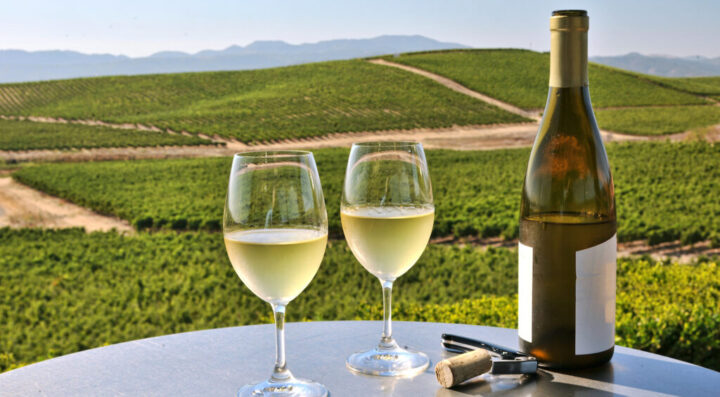The history of Sauvignon Blanc is a long and fascinating one. This white wine grape variety has been grown in various parts of the world for centuries, from its roots in the Loire Valley of France to its modern-day prominence in California, Chile, New Zealand, and South Africa.
Sauvignon Blanc traces its origin back to the Loire Valley of France where it was first cultivated by monks during the Middle Ages. It was not until the 16th century that it began to be planted in greater numbers throughout Bordeaux and other regions. Over time, it became a popular variety among winemakers who prized its bright acidity that balanced out more full-bodied reds such as Cabernet Sauvignon and Merlot.
In addition to being grown extensively in France, Sauvignon Blanc also spread throughout Europe with plantings noted as far north as Germany and Austria by the 18th century. By this time it had become established as an important varietal for both still wines and sparkling wines like Champagne.
As European settlers brought grape cuttings with them to their new homelands around the world during colonial times, Sauvignon Blanc began appearing on other continents too.
Characteristics of Sauvignon Blanc

White wine sauvignon blanc is one of the most popular white wines out there. It has a crisp, fresh taste that pairs nicely with many different dishes. This wine is produced in a variety of regions around the world, including France, New Zealand, Chile, and South Africa. Usually served as an unoaked or lightly oaked wine, Sauvignon Blanc can vary greatly from region to region and winery to winery. Here are some characteristics that define this classic white varietal:
- Taste ─ Sauvignon Blanc has a dry taste that is often described as having flavors of citrus fruit (especially grapefruit), green apple, melon, and other tropical fruits such as passionfruit or lime. Some bottles also have herbal notes like grassy hay or even bell pepper-like characteristics which give them more complexity. This makes it very versatile – you can pair it with food from almost any cuisine!
- Aroma ─ Sauvignon Blanc typically has strong aromas of citrus fruits such as lemon and grapefruit, but can also have floral scents like those of jasmine or honeysuckle flowers. Additionally, you may note hints of herbs like basil and thyme along with grassy notes due to their high level of acidity.
Factors Affecting the Flavors of the Wine

Climate
Climate is one of the most significant factors that can affect the flavors of Sauvignon Blanc. Wines grown in cool climates tend to have a crisp, green, and herbaceous flavor, while wines grown in warmer climates tend to have a more tropical and fruit-forward flavor. For example, wines grown in the Marlborough region of New Zealand have a more fruit-forward flavor, while those grown in the Loire Valley in France have a more herbaceous flavor.
Soil
The type of soil in which the grapes are grown can also have an impact on the flavor of Sauvignon Blanc. For example, soils rich in minerals such as calcium and chalk can produce wines that are high in minerals, while soils rich in clay can produce wines that are more full-bodied.
Winemaking Techniques
Winemaking techniques can also affect the flavor profile of this type of wine. For example, the choice of yeast strain, fermentation temperature, and the aging process can all play a role in determining the final flavor of the wine.
For instance, some winemakers may choose to ferment the wine in stainless steel tanks, while others may choose to ferment in oak barrels. The use of oak can add flavors of vanilla and spice to the wine, while the use of stainless steel can preserve the fresh and crisp flavors of the wine.
Popular Regions for Sauvignon Blanc

It is one of the most popular types of white wine, and it’s produced in a variety of regions around the world. From classic French styles to zesty New Zealand bottlings, Sauvignon Blanc can be enjoyed in many different forms. Here are some of the most popular regions for producing this delightful white wine.
France: The Loire Valley and Bordeaux have long been known for their excellent Sauvignon Blancs, with crisp and refreshing notes of lemon, lime, gooseberry, and fresh-cut grass. These wines tend to be quite complex yet elegant on the palate. They pair well with seafood dishes like oysters or shrimp scampi as well as poultry dishes like roasted chicken or turkey.
New Zealand: New Zealand has quickly become a major player in the world of Sauvignon Blanc production over the past few decades thanks to its bright and vibrant flavors that are perfect for summer sipping or pairing with shellfish such as mussels or crab cakes. Look for high acidity combined with ripe fruit flavors such as passionfruit and peach along with herbal notes like lemongrass and bell pepper.
Food Pairings with Sauvignon Blanc
This is a crisp, dry white wine that has become popular in recent years. Its citrusy flavors and herbal notes make it an ideal partner for many dishes. From light salads to heartier entrees, Sauvignon Blanc has the versatility to pair well with a variety of foods.
When pairing food with it, consider dishes that have bright and fresh flavors. This type of wine pairs particularly well with seafood and shellfish such as shrimp, scallops, crab, or lobster. For an appetizer or light meal, serve mussels cooked in a garlic-butter sauce or grilled calamari topped with lemon wedges and olive oil – both of which go great with a glass of Sauvignon Blanc.
For something a bit heartier try grilled pork chops served alongside roasted vegetables such as potatoes, carrots, and Brussels sprouts. The sweetness of the vegetables will highlight the herbal notes in the wine while still allowing its fruity flavors to shine through. Grilled chicken breasts marinated in herbs also pair nicely with this white wine option – just be sure not to overpower the subtlety of each component by using too much seasoning on your meat!
Conclusion
Sauvignon Blanc white wine is a light and refreshing choice for any occasion. It has a crisp, fruity flavor that is well suited to many types of food and can be enjoyed on its own or with food. With its light body, Sauvignon Blanc pairs well with salads, seafood, poultry, and cheeses.
Its distinctive flavor profile makes it a great choice for entertaining guests or enjoying it at home. Whether you’re looking for an easy-drinking accompaniment to your meal or something special to sip on its own, Sauvignon Blanc should be one of your go-to wines.




